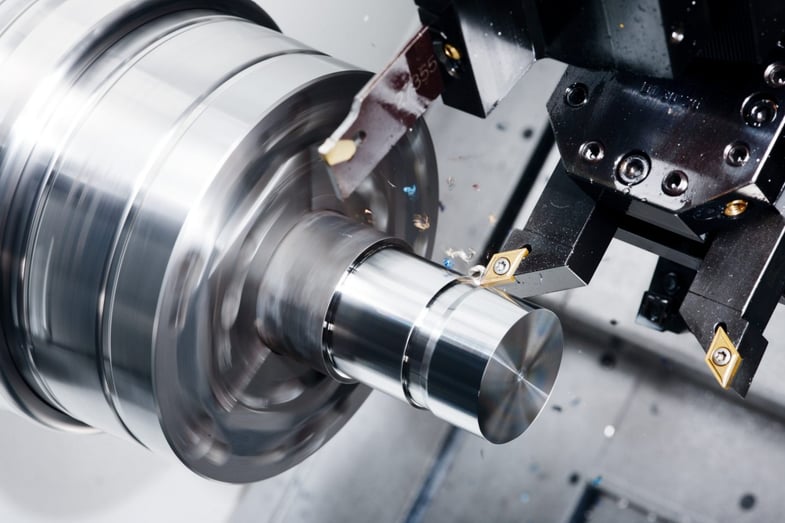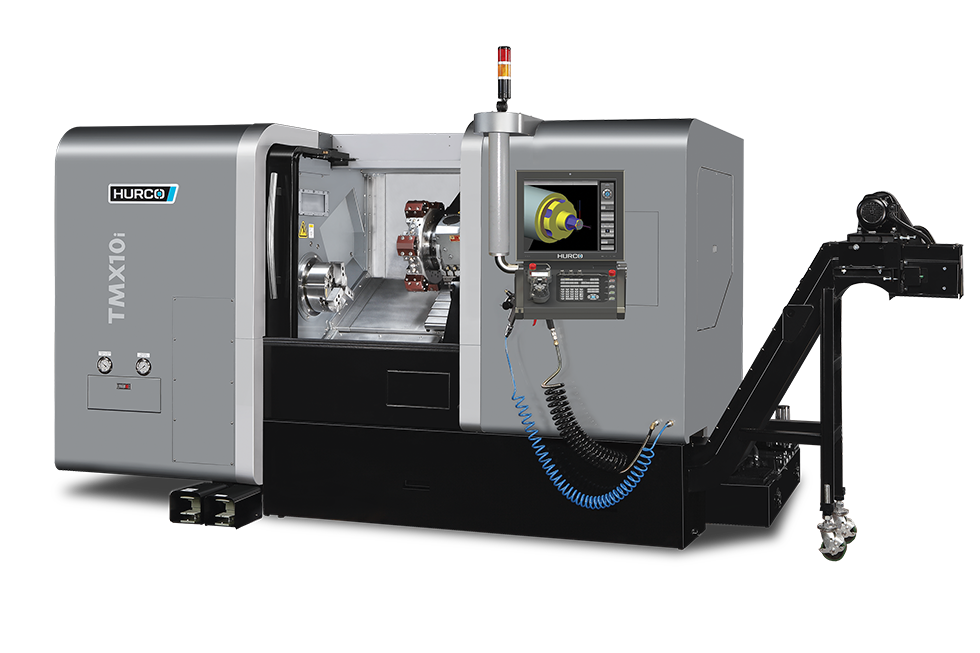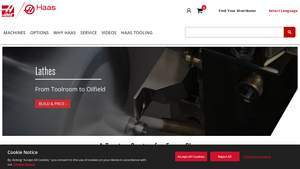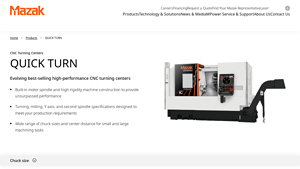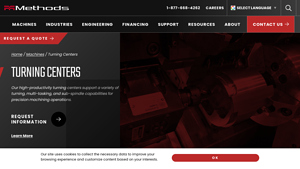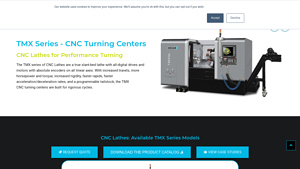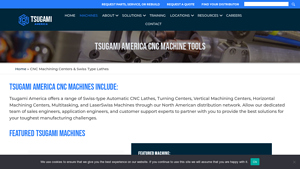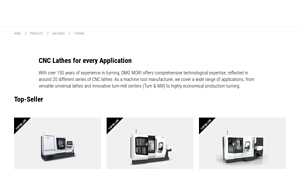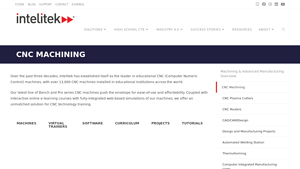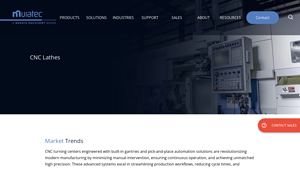Cnc Turning Center Machine Guide: Type, Cost, Top List…
Introduction: Navigating the Global Market for cnc turning center machine
In the dynamic landscape of global manufacturing, sourcing a CNC turning center machine can be a daunting task for B2B buyers. With the increasing complexity of machining requirements and diverse supplier options, making an informed purchasing decision is critical. This guide addresses the challenges of navigating the international market by providing a comprehensive overview of CNC turning centers, including their various types, applications, and key features.
From understanding the differences between high-performance models to exploring the intricacies of supplier vetting, this resource equips buyers with actionable insights that empower them to select the right machinery for their operations. Whether you are operating in Africa, South America, the Middle East, or Europe—regions such as Saudi Arabia and Germany—this guide is tailored to help you streamline your procurement process.
By delving into essential factors such as cost considerations, machine specifications, and the latest technological advancements, we aim to enhance your understanding of CNC turning centers. Our goal is to facilitate your journey towards making strategic investments that drive productivity and efficiency in your manufacturing processes. With this guide, you will be better positioned to navigate the complexities of the global market and secure the machinery that aligns with your business objectives.
Understanding cnc turning center machine Types and Variations
| Type Name | Key Distinguishing Features | Primary B2B Applications | Brief Pros & Cons for Buyers |
|---|---|---|---|
| Standard CNC Turning Center | Basic lathe functionality with automated controls | General machining, prototyping | Pros: Cost-effective, easy to operate. Cons: Limited advanced features. |
| Multi-Axis CNC Turning Center | Capable of simultaneous multi-axis machining | Complex part manufacturing | Pros: High precision, versatile. Cons: Higher initial investment. |
| Swiss-Type CNC Turning Center | Designed for high-speed, small-diameter workpieces | Medical devices, electronics | Pros: Excellent for tight tolerances. Cons: Limited to small parts. |
| Vertical CNC Turning Center | Vertical spindle orientation for enhanced chip removal | Aerospace, automotive components | Pros: Efficient for large workpieces. Cons: Requires more floor space. |
| Horizontal CNC Turning Center | Horizontal spindle for better stability and larger workpiece capacity | Heavy machinery, large parts | Pros: Greater stability, suitable for heavy work. Cons: Higher maintenance. |
What Are the Characteristics of Standard CNC Turning Centers?
Standard CNC turning centers are the backbone of many machine shops, offering essential lathe functionalities coupled with automated controls. These machines are ideal for general machining tasks and prototyping, making them a popular choice for businesses looking to produce simple components. When considering a standard CNC turning center, buyers should evaluate the machine’s ease of use and cost-effectiveness against its limited advanced features, which may not meet the demands of more complex manufacturing processes.
How Do Multi-Axis CNC Turning Centers Enhance Production?
Multi-axis CNC turning centers are designed to handle complex machining tasks by allowing simultaneous movement along multiple axes. This capability is crucial for producing intricate components with high precision, making them suitable for industries like aerospace and automotive. While the versatility and accuracy of multi-axis machines are significant advantages, potential buyers should weigh these benefits against the higher initial investment required to acquire such technology.
What Makes Swiss-Type CNC Turning Centers Unique?
Swiss-type CNC turning centers excel in the production of high-speed, small-diameter workpieces, often used in the medical and electronics sectors. Their design allows for exceptional precision and tight tolerances, making them invaluable for applications where detail is critical. However, buyers should note that these machines are typically limited to smaller parts, which could restrict their applicability in broader manufacturing scenarios.
Why Choose Vertical CNC Turning Centers for Large Workpieces?
Vertical CNC turning centers feature a vertical spindle orientation, which enhances chip removal efficiency and is particularly beneficial for large workpieces. These machines are commonly utilized in industries such as aerospace and automotive, where large, complex parts are prevalent. While they offer significant efficiency advantages, buyers must consider the increased floor space required for installation compared to more compact designs.
What Advantages Do Horizontal CNC Turning Centers Offer?
Horizontal CNC turning centers provide superior stability and are capable of handling larger workpieces, making them ideal for heavy machinery applications. Their horizontal spindle design helps maintain precision during the machining process, which is essential for producing high-quality components. However, prospective buyers should be aware of the higher maintenance requirements associated with these machines, as well as the need for a more extensive setup area.
Key Industrial Applications of cnc turning center machine
| Industry/Sector | Specific Application of CNC Turning Center Machine | Value/Benefit for the Business | Key Sourcing Considerations for this Application |
|---|---|---|---|
| Aerospace | Precision components manufacturing | High accuracy in producing lightweight parts, reducing overall aircraft weight and improving fuel efficiency. | Need for high precision, compliance with industry standards, and reliable after-sales support. |
| Automotive | Production of engine components | Enhanced productivity through automated processes, leading to reduced lead times and costs. | Requirement for versatility in handling various materials and configurations, as well as scalability. |
| Oil & Gas | Fabrication of valve bodies and fittings | Increased reliability and safety in critical applications, minimizing downtime and maintenance costs. | Importance of durability in harsh environments and adherence to safety regulations. |
| Medical Devices | Manufacturing surgical instruments and implants | Ensures precision and consistency in critical healthcare applications, enhancing patient safety. | Need for compliance with stringent health regulations and material certifications. |
| Electronics | Production of housings and connectors | Facilitates rapid prototyping and mass production, improving time-to-market for new products. | Consideration for flexibility in design changes and integration with automated systems. |
How is CNC Turning Center Machine Used in Aerospace Manufacturing?
In the aerospace industry, CNC turning centers are essential for producing precision components such as turbine blades, landing gear parts, and housing for avionics. These machines address the need for high accuracy and lightweight designs, which are crucial for fuel efficiency. Buyers from this sector should prioritize machines with advanced capabilities for high-tolerance machining and compliance with aerospace standards, as well as robust support for maintenance and training.
What Role Does CNC Turning Play in Automotive Component Production?
CNC turning centers in the automotive sector are utilized to manufacture a wide range of engine components, including crankshafts and camshafts. The automation and precision provided by these machines enhance productivity while reducing lead times and operational costs. International buyers, particularly in emerging markets, should focus on machines that offer flexibility for different materials and configurations, ensuring the ability to adapt to changing production demands.
Why is CNC Turning Important in Oil & Gas Applications?
In the oil and gas industry, CNC turning centers are used for fabricating critical components like valve bodies and fittings that require high durability and reliability. The precision machining ensures that these components meet stringent safety standards, reducing the risk of failures in harsh environments. Buyers must consider the machine’s ability to handle tough materials and provide consistent quality, along with compliance with safety regulations specific to their region.
How Does CNC Turning Benefit the Medical Device Sector?
CNC turning centers are pivotal in the medical devices sector for manufacturing surgical instruments and implants that demand high precision and consistency. This technology helps ensure that products meet strict health regulations, which is vital for patient safety. Buyers in this field should look for machines that offer advanced capabilities for precision machining and material certifications, as well as support for regulatory compliance.
What Advantages Does CNC Turning Provide in Electronics Manufacturing?
In the electronics industry, CNC turning centers are employed to produce housings, connectors, and other components that require rapid prototyping and mass production. This capability allows companies to shorten their time-to-market for new products significantly. Buyers should prioritize machines that offer flexibility in design changes and integration with automated production systems, ensuring responsiveness to market demands and technological advancements.
3 Common User Pain Points for ‘cnc turning center machine’ & Their Solutions
Scenario 1: Difficulty in Machine Selection Based on Production Needs
The Problem: B2B buyers often struggle with selecting the right CNC turning center machine that aligns with their specific production requirements. With various models featuring different spindle types, chuck sizes, and multi-tasking capabilities, buyers may find it overwhelming to determine which machine will deliver the best performance for their intended applications. This can lead to costly mistakes, such as purchasing a machine that is either over-specified or under-specified for their needs, ultimately impacting productivity and profitability.
The Solution: To effectively select the right CNC turning center, buyers should conduct a thorough analysis of their production requirements, including the types of materials they will be machining, part complexity, and volume. Engaging with suppliers who offer tailored consultations can provide insights into the capabilities of different machines. For example, if a buyer frequently works with aluminum and requires high-speed machining, opting for a turning center with a built-in motor spindle designed for non-ferrous materials would be ideal. Additionally, assessing automation options, such as integrated robotics or tool changers, can enhance operational efficiency. Buyers should also consider future scalability—investing in a versatile machine can accommodate varying production needs over time.
Scenario 2: Challenges in Achieving Consistent Machining Accuracy
The Problem: Another common pain point for B2B buyers is maintaining consistent machining accuracy across different production runs. Factors such as machine vibration, tool wear, and setup errors can lead to variability in part dimensions, resulting in rework and increased operational costs. This inconsistency can also affect product quality, making it challenging to meet customer specifications and regulatory standards.
The Solution: To mitigate these challenges, buyers should prioritize CNC turning centers with high rigidity construction and advanced CNC technology that minimizes vibration during operation. Machines equipped with features such as roller guides and integral motor spindles can significantly enhance machining stability and accuracy. Regular preventive maintenance schedules should also be established to monitor tool wear and machine performance. Implementing a robust setup process, including the use of probing systems to verify part dimensions before full production, can further enhance accuracy. Additionally, investing in training for operators on best practices for machine setup and tool management can lead to more consistent results.
Scenario 3: Integration of Automation for Increased Productivity
The Problem: Many B2B buyers face the challenge of integrating automation into their existing CNC turning center operations. While automation can significantly enhance productivity and reduce labor costs, the complexity of integration can be daunting. Companies may worry about the upfront investment, potential disruption to existing workflows, and the learning curve associated with new technologies.
The Solution: To successfully integrate automation, buyers should start by assessing their current processes to identify areas where automation can provide the most benefit. Investing in modular automation systems, such as collaborative robots (cobots) that can be easily programmed and adapted to various tasks, can offer a less disruptive entry into automation. For instance, using systems like the Ez LOADER can automate part loading and unloading without extensive modifications to the existing setup. Buyers should also consider partnering with suppliers who provide training and support for automation solutions to ensure smooth implementation. Gradually scaling automation efforts and measuring productivity improvements can help justify the initial investment and guide future automation strategies.
Strategic Material Selection Guide for cnc turning center machine
What Are the Key Materials Used in CNC Turning Centers?
When selecting materials for CNC turning center machines, it is essential to consider their properties, advantages, and limitations. The choice of material can significantly influence the performance, durability, and cost-effectiveness of the machining process. Below are analyses of four common materials used in CNC turning centers: steel, aluminum, brass, and titanium.
How Does Steel Perform in CNC Turning Applications?
Steel is one of the most widely used materials in CNC turning due to its excellent mechanical properties. It typically has high tensile strength and good wear resistance, making it suitable for heavy-duty machining applications. Steel can withstand high temperatures and pressures, which is crucial for operations involving tough materials.
Pros: Steel is durable, relatively cost-effective, and versatile, suitable for producing a wide range of components. It can be heat-treated to enhance its properties further, allowing for customization based on specific application needs.
Cons: The primary drawbacks of steel include its weight and susceptibility to corrosion if not properly treated. Machining steel can also be more complex, requiring specialized tools and techniques to achieve desired tolerances.
Impact on Application: Steel is compatible with various media, including oil and gas, automotive, and aerospace applications, where strength and reliability are paramount.
Considerations for International Buyers: Buyers should ensure compliance with international standards such as ASTM or DIN, especially in regions like Europe and the Middle East, where material specifications are strictly regulated.
What Are the Advantages of Using Aluminum in CNC Turning?
Aluminum is favored in CNC turning for its lightweight and excellent corrosion resistance. It is easy to machine and can be produced in various alloys, each offering unique properties that can be tailored to specific applications.
Pros: The primary advantage of aluminum is its low density, which makes it ideal for applications where weight reduction is critical, such as in the aerospace and automotive industries. It also has good thermal and electrical conductivity.
Cons: However, aluminum is less durable than steel and can be prone to deformation under high stress. Additionally, it may require surface treatments to enhance its wear resistance.
Impact on Application: Aluminum is particularly suitable for components that require good strength-to-weight ratios and corrosion resistance, making it ideal for outdoor applications.
Considerations for International Buyers: Buyers in regions such as Africa and South America should be aware of the availability of specific aluminum alloys and their compliance with local standards.
Why Choose Brass for CNC Turning Projects?
Brass is another popular material for CNC turning, known for its excellent machinability and aesthetic appeal. It is often used in applications where low friction and corrosion resistance are necessary.
Pros: Brass offers good thermal and electrical conductivity, making it suitable for electrical components. It is also resistant to corrosion, which is beneficial for plumbing and marine applications.
Cons: The main disadvantage of brass is its cost, which can be higher than steel and aluminum. Additionally, it is not as strong as steel, limiting its use in high-stress applications.
Impact on Application: Brass is ideal for components such as fittings, valves, and decorative items where appearance and low friction are important.
Considerations for International Buyers: When sourcing brass, buyers should consider the specific grades and ensure compliance with standards such as JIS or ASTM, especially in markets like Germany.
What Makes Titanium a Unique Choice in CNC Turning?
Titanium is renowned for its high strength-to-weight ratio and exceptional corrosion resistance, making it a premium choice for CNC turning. It is particularly valued in aerospace and medical applications where performance is critical.
Pros: Titanium’s durability and resistance to extreme temperatures and corrosive environments make it ideal for high-performance applications. It also has a low density, contributing to weight savings.
Cons: The primary drawback of titanium is its high cost and the complexity involved in machining it. Specialized tools and techniques are often required, which can increase production time and costs.
Impact on Application: Titanium is suitable for components that must withstand harsh environments, such as aerospace and medical implants.
Considerations for International Buyers: Buyers should ensure that titanium meets international standards and specifications, particularly in regions with stringent quality requirements like the Middle East and Europe.
Summary of Material Selection for CNC Turning Centers
| Material | Typical Use Case for CNC Turning Center Machine | Key Advantage | Key Disadvantage/Limitation | Relative Cost (Low/Med/High) |
|---|---|---|---|---|
| Steel | Heavy-duty components in automotive and aerospace | High durability and strength | Susceptible to corrosion; complex machining | Medium |
| Aluminum | Lightweight parts in aerospace and automotive | Excellent corrosion resistance | Less durable than steel; deformation risk | Medium |
| Brass | Fittings and decorative components | Low friction and good conductivity | Higher cost; lower strength | High |
| Titanium | Aerospace and medical components | Exceptional strength-to-weight ratio | High cost and machining complexity | High |
This guide provides a comprehensive overview of material selection for CNC turning centers, helping international B2B buyers make informed decisions based on their specific needs and regional standards.
In-depth Look: Manufacturing Processes and Quality Assurance for cnc turning center machine
What Are the Main Stages of Manufacturing for CNC Turning Center Machines?
The manufacturing of CNC turning center machines involves several key stages, each critical to ensuring the machine’s performance and longevity. The primary stages include material preparation, forming, assembly, and finishing.
How Is Material Prepared for CNC Turning Center Machines?
Material preparation is the foundational step where raw materials, typically high-grade steel or aluminum alloys, are selected based on the machine’s specifications. This involves cutting the materials to manageable sizes, removing impurities, and ensuring they meet the requisite mechanical properties. Suppliers often conduct metallurgical tests to verify the material’s composition and strength, ensuring that it can withstand the rigors of machining.
What Forming Techniques Are Used in CNC Turning Center Manufacturing?
Forming is the stage where the raw materials are shaped into the components of the CNC turning center. This process typically involves advanced machining techniques such as CNC milling, turning, and grinding. High-precision equipment is used to create parts like the spindle, bed, and turret. Advanced techniques like laser cutting and water jet cutting may also be employed for intricate designs, ensuring high precision and minimal material waste.
How Is Assembly Conducted for CNC Turning Center Machines?
The assembly stage integrates all the individual components into a cohesive machine. This process requires skilled technicians who meticulously follow engineering specifications and assembly protocols. Components are aligned and secured using high-torque fasteners, ensuring structural integrity. Additionally, during assembly, various sub-systems, such as the electrical, hydraulic, and cooling systems, are integrated, which are crucial for the machine’s operational efficiency.
What Finishing Processes Are Important for CNC Turning Centers?
Finishing processes enhance the machine’s durability and aesthetic appeal. This stage may include surface treatment techniques such as anodizing, coating, or polishing. These treatments protect against corrosion and wear, ensuring the machine maintains its operational integrity over time. Additionally, finishing may involve precision measuring tools to guarantee that each component meets tight tolerances.
What Quality Assurance Standards Are Relevant for CNC Turning Center Machines?
Quality assurance is vital in the manufacturing of CNC turning center machines. Compliance with international standards such as ISO 9001 ensures that manufacturers maintain consistent quality management systems. Other industry-specific certifications, such as CE marking in Europe and API standards for oil and gas applications, may also be relevant depending on the end-use of the machines.
How Are Quality Control Checkpoints Established in CNC Manufacturing?
Quality control (QC) checkpoints are integrated throughout the manufacturing process to ensure every component meets quality standards. Key checkpoints include:
-
Incoming Quality Control (IQC): This initial checkpoint evaluates the quality of raw materials before they enter the production line. It ensures that only materials that meet the specified standards are used.
-
In-Process Quality Control (IPQC): During the manufacturing stages, IPQC monitors the production process through regular inspections and tests. This includes measuring dimensions and assessing surface finishes to identify any deviations from specifications early in the process.
-
Final Quality Control (FQC): After assembly, FQC involves comprehensive testing of the entire machine. This may include functional tests, performance evaluations, and safety checks to ensure that the machine operates according to the manufacturer’s specifications.
What Common Testing Methods Are Employed in CNC Turning Center Quality Control?
Several testing methods are commonly employed to verify the quality and performance of CNC turning centers:
-
Non-Destructive Testing (NDT): Techniques such as ultrasonic testing, magnetic particle inspection, and dye penetrant testing ensure that components are free from defects without damaging them.
-
Dimensional Inspection: Using precision measuring instruments like calipers, micrometers, and coordinate measuring machines (CMM), manufacturers can verify that all components are within specified tolerances.
-
Functional Testing: This involves running the CNC machine through various operational cycles to ensure all systems function correctly and efficiently.
How Can B2B Buyers Verify Supplier Quality Control Practices?
B2B buyers looking to ensure the quality of CNC turning center machines can employ several strategies:
-
Supplier Audits: Conducting on-site audits allows buyers to assess the manufacturing processes, quality control measures, and overall operational standards of potential suppliers.
-
Requesting Quality Reports: Suppliers should provide documentation that outlines their quality control processes, including inspection reports and compliance certifications.
-
Third-Party Inspections: Engaging third-party inspection services can provide an unbiased assessment of the manufacturer’s quality standards and practices, offering additional assurance to buyers.
What Are the Quality Control and Certification Nuances for International B2B Buyers?
International B2B buyers, particularly from regions like Africa, South America, the Middle East, and Europe, should be aware of specific nuances related to quality control and certification:
-
Regional Standards: Different regions may have distinct regulatory requirements. For instance, the CE mark is essential for products sold within the European Union, while various certifications may be necessary in the Middle East or Africa.
-
Import Regulations: Buyers must understand the import regulations in their respective countries, which may include specific quality and safety standards that products must meet before entering the market.
-
Supply Chain Transparency: Establishing clear communication with suppliers about quality standards, certifications, and compliance can help mitigate risks associated with importing machinery.
By understanding these manufacturing processes and quality assurance practices, B2B buyers can make informed decisions when sourcing CNC turning center machines, ensuring they receive high-quality products that meet their operational needs.
Practical Sourcing Guide: A Step-by-Step Checklist for ‘cnc turning center machine’
Introduction
When sourcing a CNC turning center machine, international B2B buyers must navigate a complex landscape of specifications, suppliers, and market conditions. This guide serves as a practical checklist to streamline your procurement process, ensuring you make informed decisions that align with your production needs and budget constraints.
Step 1: Define Your Technical Specifications
Before initiating your search, it’s essential to determine the specific technical requirements of your CNC turning center. This includes understanding the materials you’ll be machining, desired spindle speeds, and the complexity of the parts. A clear set of specifications will not only help you communicate effectively with suppliers but also ensure you select a machine that meets your operational demands.
- Consider key features such as the number of axes, chuck sizes, and the need for additional capabilities like milling or Y-axis machining.
- Assess the required precision and tolerances based on your product specifications.
Step 2: Research Potential Suppliers
Once your specifications are clear, start researching potential suppliers. Look for manufacturers with a solid reputation in the CNC machine industry, particularly those that cater to your region, such as Africa, South America, the Middle East, or Europe.
- Evaluate their product range to ensure they offer machines that align with your defined specifications.
- Check for customer reviews and testimonials to gauge the reliability and performance of their machines.
Step 3: Evaluate Supplier Certifications
Confirm that your shortlisted suppliers have the necessary certifications and compliance with international quality standards. This step is crucial for ensuring that the machines meet safety and performance benchmarks.
- Look for ISO certifications or other relevant industry-specific qualifications.
- Verify compliance with local regulations that may apply to machine operations in your region.
Step 4: Request Detailed Quotes
Contact your selected suppliers to request detailed quotes. This should include not only the machine cost but also additional fees such as shipping, installation, and training.
- Compare the total cost of ownership by factoring in maintenance, tooling, and potential operational costs.
- Look for transparency in pricing to avoid hidden charges that could impact your budget.
Step 5: Inquire About After-Sales Support
After-sales support is a vital consideration when sourcing CNC turning machines. Ensure that your supplier offers robust support services, including maintenance, troubleshooting, and spare parts availability.
- Ask about warranty terms and what is covered.
- Inquire about training programs for your staff to ensure they can operate the machine effectively.
Step 6: Conduct Factory Visits or Virtual Tours
If possible, arrange to visit the supplier’s factory or request a virtual tour. This firsthand experience allows you to assess the quality of their manufacturing processes and machinery.
- Observe their production capabilities to ensure they align with your expectations.
- Meet with technical staff to discuss your requirements and gauge their expertise.
Step 7: Finalize the Purchase Agreement
Once you’ve selected a supplier, it’s time to finalize the purchase agreement. Review all terms and conditions carefully before signing.
- Ensure all specifications, delivery timelines, and payment terms are clearly outlined in the contract.
- Include clauses for recourse in case of non-compliance with the agreed terms.
By following this checklist, B2B buyers can streamline their procurement process and enhance their chances of acquiring a CNC turning center machine that meets their operational needs effectively.
Comprehensive Cost and Pricing Analysis for cnc turning center machine Sourcing
What Are the Key Cost Components in CNC Turning Center Machine Sourcing?
Understanding the cost structure of CNC turning centers is crucial for international B2B buyers. The primary cost components include materials, labor, manufacturing overhead, tooling, quality control (QC), logistics, and profit margin.
-
Materials: High-quality raw materials are essential for the production of CNC turning centers. The type of metals and components used can significantly influence costs. For example, stainless steel or high-grade aluminum may incur higher material costs but offer better performance and durability.
-
Labor: Skilled labor is necessary for both manufacturing and assembly of CNC machines. Labor costs can vary widely based on geographic location, with higher wages in Europe compared to regions in Africa or South America.
-
Manufacturing Overhead: This includes costs related to facility maintenance, utilities, and equipment depreciation. Efficient manufacturing processes can minimize these overheads, impacting the overall pricing of the machines.
-
Tooling: The cost of tooling can vary based on the complexity of the CNC machine. Advanced features like multi-axis capabilities or custom tooling can increase tooling costs, which should be factored into the total expense.
-
Quality Control: Ensuring the machine meets international standards involves additional costs for testing and certification. High-quality machines often come with certifications that assure buyers of their reliability and performance.
-
Logistics: Shipping and handling costs can add significantly to the price, particularly for international transactions. The choice of shipping method and destination can greatly influence these expenses.
-
Margin: Suppliers typically add a profit margin to cover their operational costs and ensure profitability. This margin can vary based on the supplier’s positioning in the market.
How Do Price Influencers Impact CNC Turning Center Costs?
Several factors influence the final price of CNC turning centers, particularly for international buyers.
-
Volume and Minimum Order Quantity (MOQ): Ordering in bulk can lead to significant discounts. Suppliers often have a MOQ, and meeting this threshold may unlock better pricing.
-
Specifications and Customization: Custom features or specifications can increase costs. Buyers should clearly define their requirements to avoid unexpected expenses.
-
Materials: The choice of materials not only affects performance but also the pricing. High-performance materials may come at a premium but can reduce long-term maintenance costs.
-
Quality and Certifications: Machines with recognized certifications often command higher prices due to their guaranteed performance and reliability. Buyers should weigh the importance of these certifications against their budget.
-
Supplier Factors: Supplier reputation, service support, and warranty offerings can influence pricing. Established suppliers may charge more, but they often provide better support and reliability.
-
Incoterms: Understanding Incoterms is vital for pricing clarity. They dictate the responsibilities of buyers and sellers regarding shipping, insurance, and tariffs, which can affect overall costs.
What Tips Can Help Buyers Navigate Pricing Nuances in International Sourcing?
Navigating the complexities of CNC turning center pricing requires strategic planning and negotiation skills.
-
Negotiate Terms: Engage in discussions about pricing, MOQ, and delivery terms. Suppliers may be willing to provide discounts or better terms to secure a deal.
-
Focus on Cost-Efficiency: Evaluate the total cost of ownership (TCO), including maintenance, operational efficiency, and lifespan. A lower initial price may lead to higher long-term costs.
-
Understand Pricing Nuances: Different regions have varying pricing structures due to labor and material costs. Buyers from Africa, South America, and the Middle East should compare local suppliers with international ones to find the best value.
-
Consider Currency Fluctuations: For international transactions, currency exchange rates can impact pricing. Buyers should be aware of current rates and consider locking in prices if favorable.
-
Seek Transparent Pricing: Request detailed breakdowns of costs from suppliers. This can help identify areas for potential savings and ensure that all components are accounted for.
Disclaimer on Indicative Prices
Pricing for CNC turning centers can vary significantly based on the factors discussed. This analysis provides a framework for understanding costs, but actual prices may differ based on supplier negotiations and market conditions. Always consult with suppliers for the most accurate and updated pricing information.
Alternatives Analysis: Comparing cnc turning center machine With Other Solutions
Exploring Alternatives to CNC Turning Center Machines
In the realm of precision machining, CNC turning center machines are often a go-to solution for manufacturers seeking efficiency and accuracy. However, various alternatives exist, each with unique advantages and limitations. Understanding these alternatives can help B2B buyers make informed decisions that align with their operational requirements.
| Comparison Aspect | CNC Turning Center Machine | Vertical Milling Machine | Manual Lathe |
|---|---|---|---|
| Performance | High speed and precision | Excellent for flat surfaces and complex geometries | Moderate precision, slower speeds |
| Cost | Higher initial investment | Moderate cost | Low initial investment |
| Ease of Implementation | Requires skilled operators | Easier for entry-level operators | Simple setup, minimal training needed |
| Maintenance | Requires regular servicing | Moderate maintenance | Low maintenance |
| Best Use Case | High-volume production of cylindrical parts | Complex part geometries and surfaces | Prototyping and low-volume production |
What Are the Pros and Cons of a Vertical Milling Machine as an Alternative?
Vertical milling machines serve as a strong alternative to CNC turning centers, especially for tasks that require complex geometries. The performance of vertical mills can be exceptional when machining flat surfaces or intricate designs. They typically have a moderate cost compared to CNC turning centers, making them an attractive option for businesses with budget constraints. However, while easier for entry-level operators, vertical mills may not achieve the same level of precision as CNC turning machines for cylindrical workpieces. Their maintenance is also moderate, requiring periodic checks to ensure optimal performance.
How Does a Manual Lathe Compare to CNC Turning Center Machines?
Manual lathes offer a cost-effective solution for small-scale operations or prototyping. They are easy to set up and require minimal training, making them accessible to businesses with less technical expertise. However, the performance of manual lathes is generally lower than that of CNC turning centers, particularly in terms of speed and precision. They are best suited for low-volume production and simple tasks, as they lack the automation and advanced capabilities of CNC machines. Maintenance is relatively low, but the trade-off comes in the form of increased labor costs and longer production times.
Conclusion: How Can B2B Buyers Choose the Right Machining Solution?
When evaluating machining solutions, B2B buyers should consider their specific production needs, budget constraints, and the technical expertise available within their organization. CNC turning center machines excel in high-volume, high-precision applications, making them ideal for companies that prioritize efficiency and output quality. In contrast, vertical milling machines are well-suited for complex designs and versatile applications, while manual lathes serve as a budget-friendly option for prototyping or small-scale production. By carefully weighing the pros and cons of each alternative, buyers can select the solution that best aligns with their operational goals and market demands.
Essential Technical Properties and Trade Terminology for cnc turning center machine
What Are the Key Technical Properties of CNC Turning Center Machines?
CNC turning center machines are vital for precision machining in various industries. Understanding their essential technical properties can help B2B buyers make informed decisions. Here are some critical specifications to consider:
-
Spindle Speed
The spindle speed, measured in revolutions per minute (RPM), indicates how fast the spindle can rotate. Higher spindle speeds allow for quicker machining cycles, which can significantly enhance productivity. For B2B buyers, this means lower operational costs and the ability to meet tight deadlines. -
Chuck Size
The chuck size refers to the diameter of the work-holding device that secures the material during machining. Common sizes include 6-inch, 8-inch, and 12-inch chucks. Selecting the right chuck size is crucial for accommodating different workpiece dimensions, thus affecting versatility in production capabilities. -
Axis Configuration
Most CNC turning centers are classified based on their axis configuration, such as 2-axis, 3-axis, or multi-axis systems. Multi-axis machines offer advanced capabilities for more complex machining tasks, allowing for simultaneous movements that enhance precision. Understanding axis configuration helps buyers evaluate the machine’s suitability for their specific applications. -
Tolerance Levels
Tolerance refers to the allowable variation in a dimension of the machined part. Tight tolerances (e.g., ±0.001 inches) are essential for industries like aerospace and medical devices, where precision is critical. Buyers must understand the required tolerance levels for their projects to ensure that the chosen machine can meet these specifications. -
Material Compatibility
CNC turning centers can handle various materials, including metals, plastics, and composites. Each machine may have specific capabilities regarding the hardness and type of material it can process. Buyers should assess the material requirements of their projects to select a machine that can effectively handle their needs. -
Control System
The control system is the software interface used to operate the machine. Modern CNC turning centers often feature user-friendly interfaces, such as touch panels and conversational programming, that streamline the programming process. A robust control system can reduce the learning curve for operators, thereby increasing overall efficiency.
What Are Common Trade Terms Related to CNC Turning Center Machines?
Familiarity with industry jargon is essential for effective communication and negotiation in the B2B space. Here are some common terms:
-
OEM (Original Equipment Manufacturer)
An OEM refers to a company that produces parts and equipment that may be marketed by another manufacturer. In the context of CNC machines, buyers often work with OEMs to ensure they receive high-quality components tailored to their specifications. -
MOQ (Minimum Order Quantity)
MOQ is the smallest quantity of a product that a supplier is willing to sell. Understanding MOQ is crucial for buyers, as it affects inventory management and cash flow, particularly for smaller businesses or startups. -
RFQ (Request for Quotation)
An RFQ is a document sent to suppliers requesting pricing and terms for specific products or services. This is a critical step in the procurement process, enabling buyers to compare offers and negotiate better terms. -
Incoterms (International Commercial Terms)
Incoterms are a set of predefined commercial terms published by the International Chamber of Commerce (ICC) that clarify the responsibilities of buyers and sellers in international transactions. Familiarity with these terms helps avoid misunderstandings regarding shipping, insurance, and liability. -
Lead Time
Lead time refers to the time it takes from placing an order to receiving the goods. For B2B buyers, understanding lead times is vital for planning production schedules and ensuring timely delivery to customers. -
CNC (Computer Numerical Control)
CNC refers to the automated control of machining tools by means of a computer. This technology allows for high precision and repeatability in manufacturing processes, making it a standard in modern machining operations.
By grasping these technical properties and trade terms, B2B buyers can navigate the complexities of purchasing CNC turning center machines with greater confidence and clarity.
Navigating Market Dynamics and Sourcing Trends in the cnc turning center machine Sector
What are the Current Market Dynamics and Key Trends in the CNC Turning Center Machine Sector?
The CNC turning center machine sector is experiencing robust growth, driven by several global factors. The increasing demand for precision engineering in industries such as automotive, aerospace, and medical devices is propelling the market forward. As international B2B buyers, particularly from regions like Africa, South America, the Middle East, and Europe (notably Saudi Arabia and Germany), seek advanced manufacturing solutions, the emphasis on high-performance, multi-tasking machines has intensified. Key trends include the adoption of automation and Industry 4.0 technologies, which enhance productivity and reduce lead times. Additionally, manufacturers are increasingly integrating IoT capabilities into CNC machines, allowing for real-time monitoring and predictive maintenance, thereby optimizing operational efficiency.
Emerging sourcing trends highlight the importance of local suppliers in key markets. As logistics costs rise and supply chain reliability becomes paramount, international buyers are reassessing their sourcing strategies to prioritize regional partnerships. This not only mitigates risks but also supports local economies. Furthermore, the emphasis on customization is growing, as buyers seek machines tailored to specific applications, enhancing their competitive advantage in niche markets.
How is Sustainability and Ethical Sourcing Influencing the CNC Turning Center Machine Market?
Sustainability is becoming a critical factor in the procurement of CNC turning center machines. As environmental regulations tighten globally, B2B buyers are increasingly prioritizing machines that minimize waste and energy consumption. The focus on sustainable manufacturing practices is leading to a demand for “green” certifications and materials. Buyers should consider suppliers who adhere to recognized standards, such as ISO 14001, which outlines effective environmental management systems.
Ethical sourcing is also gaining traction, with buyers scrutinizing the supply chain for transparency and sustainability. This involves evaluating the sourcing of raw materials, production processes, and labor practices. Companies that can demonstrate a commitment to ethical sourcing not only enhance their brand reputation but also appeal to a growing base of environmentally conscious consumers and businesses. The push for sustainability and ethical practices is reshaping procurement strategies, compelling buyers to align their operations with broader environmental and social governance (ESG) criteria.
What is the Brief Evolution of CNC Turning Center Machines?
The evolution of CNC turning center machines can be traced back to the mid-20th century when the first numerical control (NC) machines were introduced. Initially, these machines operated on punched tape, limiting their functionality. However, with the advent of computer technology in the 1970s, CNC machines emerged, allowing for greater precision, flexibility, and automation.
Over the decades, advancements in software and hardware have transformed CNC turning centers into highly sophisticated multi-tasking machines capable of performing various operations, including turning, milling, and drilling, all in one setup. This evolution has been driven by the need for increased productivity and efficiency in manufacturing processes. Today, CNC turning centers are equipped with advanced features like live tooling, Y-axis capabilities, and IoT integration, making them indispensable in modern manufacturing environments. For B2B buyers, understanding this evolution highlights the importance of investing in cutting-edge technology that meets current and future manufacturing demands.
Frequently Asked Questions (FAQs) for B2B Buyers of cnc turning center machine
-
1. How do I solve common issues with CNC turning centers?
To address common issues such as inaccurate machining or tool wear, start with regular maintenance and calibration of the machine. Ensure that the machine’s software is updated and that proper tooling is used for the specific materials being machined. Additionally, train operators on best practices for setup and operation. For persistent problems, consult with the manufacturer’s technical support or consider investing in advanced monitoring systems that provide real-time feedback on machine performance. -
2. What is the best CNC turning center for small to medium-scale production?
The ideal CNC turning center for small to medium-scale production typically features a compact design with versatile capabilities, such as turning and milling. Look for machines with built-in motor spindles and high-rigidity construction, which offer reliable performance across various materials. Models like the Haas ST Series or Mazak’s QUICK TURN series are popular choices, as they provide a good balance of speed, accuracy, and ease of use, making them suitable for diverse machining tasks. -
3. What factors should I consider when selecting a CNC turning center machine?
When selecting a CNC turning center, consider factors such as the machine’s specifications (spindle speed, torque, and axis travel), the types of materials you will be machining, and the complexity of your parts. Additionally, evaluate the machine’s automation capabilities, ease of programming, and after-sales support from the supplier. It’s also wise to assess the total cost of ownership, including maintenance and operational costs, to ensure a sound investment. -
4. How do I vet suppliers of CNC turning center machines internationally?
To vet suppliers, start by checking their reputation through customer reviews and testimonials. Request references from previous clients, especially those in your region. Evaluate their certifications and compliance with international quality standards, such as ISO. Additionally, engage in direct communication to assess their responsiveness and willingness to provide technical support. If possible, visit their facilities or request a virtual tour to see their operations firsthand. -
5. What are the typical payment terms for purchasing CNC machines?
Payment terms for CNC machines can vary widely depending on the supplier and the total order value. Common terms may include a deposit (usually 30-50%) upfront, with the balance due upon shipment or installation. It’s advisable to negotiate terms that align with your cash flow and project timelines. Consider using secure payment methods such as letters of credit or escrow services to protect your investment, especially in international transactions. -
6. What is the minimum order quantity (MOQ) for CNC turning centers?
The MOQ for CNC turning centers can vary by manufacturer. Some suppliers may offer single-unit sales, while others might set a minimum of two or more machines to ensure cost-effectiveness. It’s crucial to discuss this upfront with potential suppliers and explore options for customized orders if needed. If you’re considering bulk purchases, inquire about volume discounts or financing options that could ease the financial burden. -
7. How can I ensure quality assurance (QA) when sourcing CNC machines?
To ensure quality assurance, request detailed documentation on the machine’s specifications, certifications, and testing procedures from the supplier. Conduct factory acceptance tests (FAT) before shipment to verify that the machine meets your requirements. Additionally, establish a warranty and service agreement that covers maintenance and support after installation. Engaging third-party inspectors for quality checks can also provide an extra layer of assurance. -
8. What logistics considerations should I keep in mind when importing CNC turning centers?
When importing CNC turning centers, consider factors such as shipping methods, customs regulations, and import duties that may apply in your country. Work with reliable freight forwarders who have experience in handling heavy machinery. Ensure that the machines are properly packed and insured during transit to avoid damage. Plan for installation logistics and any necessary infrastructure adjustments at your facility to accommodate the new equipment.
Important Disclaimer & Terms of Use
⚠️ Important Disclaimer
The information provided in this guide, including content regarding manufacturers, technical specifications, and market analysis, is for informational and educational purposes only. It does not constitute professional procurement advice, financial advice, or legal advice.
While we have made every effort to ensure the accuracy and timeliness of the information, we are not responsible for any errors, omissions, or outdated information. Market conditions, company details, and technical standards are subject to change.
B2B buyers must conduct their own independent and thorough due diligence before making any purchasing decisions. This includes contacting suppliers directly, verifying certifications, requesting samples, and seeking professional consultation. The risk of relying on any information in this guide is borne solely by the reader.
Top 9 Cnc Turning Center Machine Manufacturers & Suppliers List
1. Haas Automation – CNC Turning Centers
Domain: haascnc.com
Registered: 1996 (29 years)
Introduction: Lathes | CNC Turning Centers | Haas Automation includes ST Series, Dual-Spindle, Box Way Series, Toolroom Lathes, Chucker Lathe, and Haas Bar Feeder. The product range offers various options for CNC turning, catering to different machining needs.
2. Mazak – QUICK TURN CNC Turning Centers
Domain: mazak.com
Registered: 1998 (27 years)
Introduction: CNC Turning Centers QUICK TURN – Evolving best-selling high-performance CNC turning centers with built-in motor spindle and high-rigidity machine construction. Features include:
– Turning, milling, Y-axis, and second spindle specifications.
– Wide range of chuck sizes: 6 inch, 8 inch, 10 inch, 12 inch, 12/15 inch, 18/21 inch.
– Continuous machining with second spindle for high-speed and high-qu…
3. Methods Machine – Turning Centers
Domain: methodsmachine.com
Registered: 1996 (29 years)
Introduction: Turning Centers from Methods Machine Tools offer high-productivity solutions for precision machining operations. Key features include:
– Support for turning, multi-tasking, and sub-spindle capabilities.
– Sophisticated CNC machining capabilities such as opposing and/or dual spindles, live tooling, multiple turrets, multi-axis machining, and B-axis machining.
– Engineered for various industries inc…
4. Hurco – TMX Series CNC Lathes
Domain: hurco.com
Registered: 1994 (31 years)
Introduction: TMX Series CNC Lathes are slant-bed lathes with all-digital drives and motors featuring absolute encoders on all linear axes. They offer increased travels, horsepower, torque, rigidity, faster rapids, and programmable tailstock. The lathes are designed for medium to large batch production and feature certified Meehanite® castings for thermal stability, oversized Z-axis guide rails, and a wide sadd…
5. Tsugami America – CNC Machines
Domain: tsugamiamerica.com
Registered: 2020 (5 years)
Introduction: Tsugami America offers a range of CNC machines including Swiss-type Automatic CNC Lathes, Turning Centers, Vertical Machining Centers, Horizontal Machining Centers, Multitasking, and LaserSwiss Machines. Featured machines include:
1. M08SY – Turning Center with Y-Axis: Performs turning, drilling, boring, cross-drilling, and CNC milling with built-in spindles for reduced vibration and enhanced res…
6. DMG MORI – Topseller NLX 2500
Domain: us.dmgmori.com
Registered: 2013 (12 years)
Introduction: CNC Lathes – DMG MORI offers over 150 years of experience in turning with around 20 different series of CNC lathes. Key models include:
1. **Topseller NLX 2500**
– Max. workpiece diameter: 18.1 in.
– Max. workpiece length: 49.4 in.
– Max. bar diameter: 3.5 in.
– Max. X-axis travel: 10.2 in.
– Max. Y-axis travel: 3.9 in.
– Max. Z-axis travel: 53 in.
2. **Topseller…
7. Intelitek – CNC Machining Solutions
Domain: intelitek.com
Registered: 1997 (28 years)
Introduction: Intelitek offers a range of CNC machining products including: 1. BenchMill 6×00 CNC Milling Center – A PC-based benchtop CNC machining center for robust CNC and advanced manufacturing instruction. 2. BenchTurn 7×00 CNC Turning Center – A versatile PC-based benchtop CNC turning center designed for robust CNC and advanced manufacturing instruction. 3. ProMill 8000 CNC Machining Center – A 3-axis, PC…
8. Hillary Machinery – CNC Lathes and Turning Centers
Domain: hillarymachinery.com
Registered: 2011 (14 years)
Introduction: CNC Lathes and Turning Centers include: 2-Axis CNC Lathes, 3-Axis Live Tool CNC Lathes (Turn & Mill), Multi-Axis CNC Lathes, Multi-Spindle Multi-Turret Vertical Turning Lathes, Automated Turning Centers. These machines are versatile for shaping and cutting materials, primarily metals, with capabilities ranging from simple 2-Axis to complex multi-axis operations with live tools. Financing options a…
9. Muratec – CNC Lathes
Domain: muratec-usa.com
Registered: 1997 (28 years)
Introduction: Muratec offers versatile CNC lathes designed for modern manufacturing, featuring built-in gantries and pick-and-place automation to minimize manual intervention and ensure continuous operation. Key product lines include: 1. Single Spindle Lathes: Suitable for job shops and production lines, excelling at third operations to increase productivity and reduce labor costs. Featured products: Single Spi…
Strategic Sourcing Conclusion and Outlook for cnc turning center machine
How Can Strategic Sourcing Enhance Your CNC Turning Center Machine Investments?
In today’s competitive manufacturing landscape, strategic sourcing of CNC turning center machines is essential for international B2B buyers. By aligning procurement strategies with production goals, businesses can optimize their operational efficiency and reduce costs. Key takeaways include understanding the performance specifications required for your specific machining tasks and leveraging automation technologies to enhance productivity.
Investing in high-quality CNC turning centers, such as those offered by leading manufacturers, ensures that buyers can meet diverse machining requirements while maintaining precision and reliability. Additionally, considering local suppliers in regions like Africa, South America, the Middle East, and Europe can facilitate better service support and quicker response times.
As the industry continues to evolve with advancements in technology and automation, the future looks promising for those who prioritize strategic sourcing. We encourage buyers to actively explore partnerships with reputable suppliers and invest in machines that not only meet current needs but are also adaptable for future innovations. Embrace this opportunity to enhance your manufacturing capabilities and stay ahead in a rapidly changing market.
